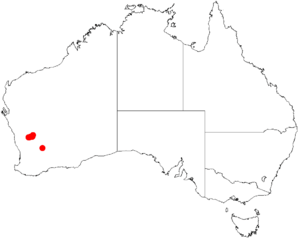Acacia cerastes facts for kids
Quick facts for kids Acacia cerastes |
|
|---|---|
| Conservation status | |
| Scientific classification | |
| Genus: |
Acacia
|
| Species: |
cerastes
|
 |
|
| Occurrence data from AVH | |
Acacia cerastes is a type of shrub, a plant with many woody stems. It belongs to the Acacia family, also known as wattles. This shrub grows naturally in a small part of the northern Wheatbelt area in Western Australia.
Contents
What Does Acacia Cerastes Look Like?
This shrub stands upright and has many branches that grow in a tangled way. It usually reaches about 1.5 m (4 ft 11 in) (about 5 feet) tall. Its small branches are round and twisted, with green or brown stripes.
Leaves and Flowers
Like most Acacia plants, Acacia cerastes does not have true leaves. Instead, it has special leaf-like parts called phyllodes. These phyllodes look like tiny, horn-shaped bumps along the branches, only about 1 mm (0.039 in) long. They are evergreen, meaning they stay green all year.
The shrub blooms with bright yellow flowers between August and November. These flowers grow in small, round clusters, with about 30 golden flowers in each cluster.
Seed Pods
After flowering, Acacia cerastes produces long, thin seed pods. These pods open up to release their seeds. They are usually rounded and squeezed in between where the seeds sit. The pods are thin and leathery, growing up to about 4.5 cm (1.8 in) (about 1.8 inches) long and 3 to 4 mm (0.12 to 0.16 in) wide.
How Was Acacia Cerastes Named?
The plant was first officially described by a botanist named Bruce Maslin in 1995. He wrote about it in a scientific journal called Nuytsia.
For a short time in 2003, another botanist, Leslie Pedley, reclassified it under a different genus called Racosperma. However, by 2006, it was moved back to the Acacia genus, where it remains today.
Where Does Acacia Cerastes Grow?
Acacia cerastes is found in a small area of Western Australia. This area is located between the towns of Perenjori, Westonia, and Yalgoo.
It prefers to grow in rocky soil that is thin and sits over ironstone on hillsides. You can mostly find it in the Mount Gibson Sanctuary and on Ninghan Station. The first sample of this plant used for scientific study was collected by botanist Charles Austin Gardner in 1952 from the Mount Gibson area.


